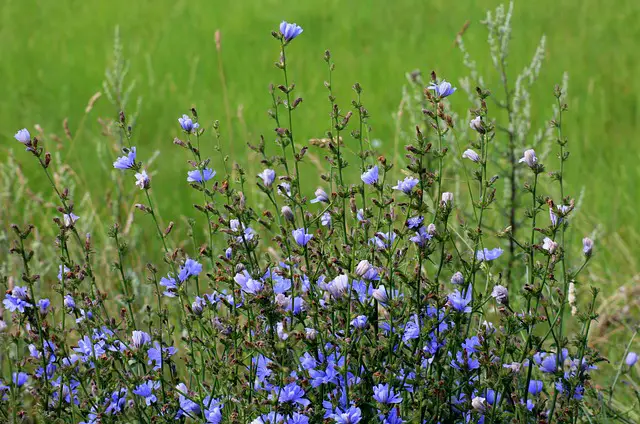Chicory (Cichorium intybus) or sometimes called wild endive, is a woody perennial plant and a member of the dandelion family. It typically has blue flowers and leaves that look like dandelion leaves. In fact, in its basal rosette form, before it develops its long woody stems and flowers, it looks very similar to a dandelion plant. The blue flowers that are present on mature chicory plants look very similar to cornflowers (Centaurea cyanus). It is often seen growing along roadsides. While often disregarded and even considered a weed, chicory is a popular plant with foragers.
Is Chicory Edible?
The chicory plant has a long history of culinary use. All parts of the plant are edible with a variety of uses. People safely consume chicory leaves, flowers, and roots. Due to the presence of sesquiterpene lactones, chicory has a slightly bitter flavor. To some, this makes it favorable for adding in salads. Its leaves have a long history of being used in salads. In fact, the Ancient Greeks and Ancient Romans often ate chicory greens. On the other hand, people have used chicory roots as a coffee substitute for centuries.
Chicory is a non-native plant in the United States. Chicory species are native plants to Europe, Western Asia, and Northern Africa. Today, it’s a very common plant in North America, especially in the Southern US.
The edible leaves are typically thrown into salads in the early spring and fall. While they can be eaten in the summer, the naturally bitter taste of the leaves is even more bitter in the hot summer months. You can blanch the leaves before tossing them in a salad to remove some of the bitter flavors if it’s too much for you.
The plant is rich in dietary fiber and has a history of usage as a feedstock for animals such as cattle, sheep, and goats. The plant is grown commercially in France, South Africa, and Nebraska, typically for the purpose of feeding livestock. As a livestock feed, chicory generally contains 22-24% crude protein. This compares to 18-25% crude protein in alfalfa hay. What’s more, chicory has 50-55% TDN or total digestible nutrients, while alfalfa has 45-60% TDN.
Chicory roots can grow to be quite hefty, sometimes weighing three pounds. These roots are often harvested, cut into pieces and dried, and then roasted, similar to the way coffee beans are roasted. This shrinks down the root.
During this process, chicory root caramelizes and becomes rich in flavor. What used to be a solely bitter plant becomes a bitter-and-sweet one. Then, when it’s used as a substitute for coffee, the roots are ground up and then made into a warm drink in a process similar to how coffee is made. The roots have a high fiber content and make a sweet, bitter, and rich coffee-like drink.
Today, coffee flavored with chicory is popular, especially in the American South. In New Orleans, the Cafe Du Monde famously serves coffee with chicory root.
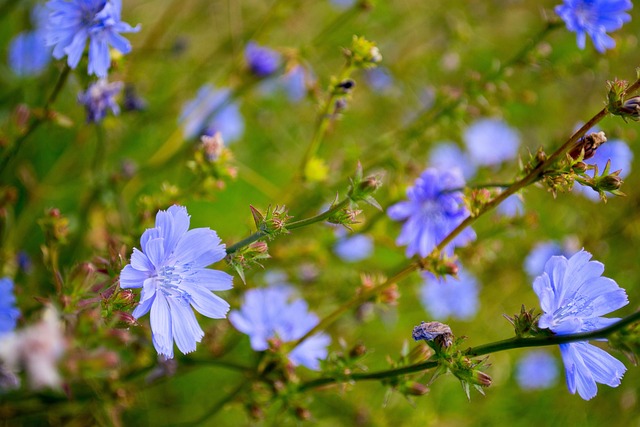
The Best Time of Year to Forage for Chicory
In the early spring, people are mostly harvesting the young leaves. This may be difficult because wild chicory leaves, especially young leaves, are easy to confuse with other plants.
You’re looking for large hairy leaves with deep lobes. The stems have fine hair. When you cut the stem in half, you’ll find a white sap inside that looks milk-like. The leaves get smaller the higher up the stem they go. Spring is the best time to harvest chicory leaves.
In July through October, you’ll find blue chicory flowers. These are easy to recognize once you see them. They tend to open up early in the morning, around six am in the summer, and close up around noon as the day heats up. In the summer, most foragers leave chicory alone. The older leaves are more bitter at this time, and the roots aren’t at their peak.
In October, people usually forage for the roots. These plants like to grow in loamy soil. They have a long taproot with a system that reaches out in search of water. The roots can grow as far as five feet away from the center of the plant. You can find chicory roots that are two to four inches thick. Today, these roots are often collected, dried, roasted, and mixed with coffee beans for a delicious, rich, warm drink.
Precautions While Foraging for Chicory
Chicory loves to grow along roadsides, and a lot of people view it as a weed. These two facts are important to keep in mind when foraging for chicory.
For one thing, you don’t want to forage for any wild edibles along roadsides. The plants that grow right along the ditches may be plentiful, but they have also spent their life soaking up exhaust from vehicles. You don’t want to eat that.
For another thing, when people view a plant as a weed, they are likely to spray it with herbicide. You don’t want to forage from anyone else’s yard or along the roadside because people may be spraying those plants with chemicals.
When foraging for chicory, or any other wild edible plant, make sure that you know where this plant is growing. Make sure that it’s very unlikely anyone sprayed the plant with an herbicide and that it’s growing in a healthy environment.
As a general rule, it’s a good idea to harvest about one-third of the plant growing in any particular area. This way, the plant can spread its chicory seeds and grow again next year.
Does Chicory Go By Other Names?
Common chicory actually goes by a lot of other common names, and they tell you a fair amount about how this wild plant is perceived. For example, it’s known as Cichorium, blue dandelion, blue weed, and blue daisy, which are all names that give you some idea of what this plant looks like. The flower head is typically blue, they look a little like daisies, and the leaves look like dandelion leaves. Plus, the plant is a member of the dandelion family.
It’s also called coffee weed, cornflower, horseweed, ragged sailors, blue sailors, succory, and Italian dandelion.
Chicory and Thomas Jefferson
Chicory is a wild plant with a particularly interesting history in North America. One of the facts that gets brought up fairly often is that in 1795 Thomas Jefferson wrote a letter to George Washington mentioning chicory. He said that chicory is one of the most valuable things a farmer can have and that it can keep cattle fed quite well. He also said that it makes a “tolerable” salad.
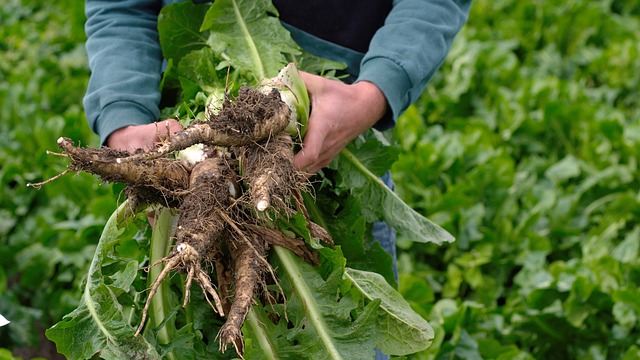
Chicory and the Civil War
At the time of the Civil War in the United States, New Orleans was a major port, especially for coffee. When the Union Navy isolated the New Orleans port, coffee was in short supply. This led to a lot more people using chicory root as a coffee substitute. While ground-up chicory can be used as a chicory coffee (without any caffeine in it), it can also be mixed with roasted coffee and made into a chicory-flavored coffee drink. This history is probably why chicory-flavored coffee is still such a big part of coffee in the South today.
Chicory and Ancient Egypt
Chicory has become an important introduced plant in North America, Australia, and New Zealand, but it’s a native plant to Europe, Northern Africa, and Western Asia. It was an important plant in Ancient Egypt, and it’s actually believed that the name “chicory” comes from the Egyptian word Ctchorium.
Ancient Egyptians used chicory as a medicinal plant. They ground up the root, leaves, and flowers to use as medicine.
Is Wild Chicory a Medicinal Herb?
Many consider chicory to be a medicinal herb. Traditionally, it has been used as a treatment for gallstones, stomach issues, and sinus problems, and as an appetite stimulant. What’s more, chicory leaves are a great source of vitamin C.
Note that because chicory is very high in fiber, it can also cause gas and bloating.
Wild Chicory Root Has A Rich Flavor With An Equally Rich History
For a plant that’s so often disregarded as a weed growing along American roadsides, chicory has a surprisingly rich flavor profile and global history. This beautiful powdery-blue flower is a lot more than meets the eye. Today, it’s being given a second look by foragers, who are finding it a fun ingredient to add to salads. And it’s still being given ample respect as a coffee substitute, especially by those in New Orleans. If you’re looking for a new relative to the dandelion to add to your salads, you’ll want to give chicory leaves a try.
Other Forms of Chicory
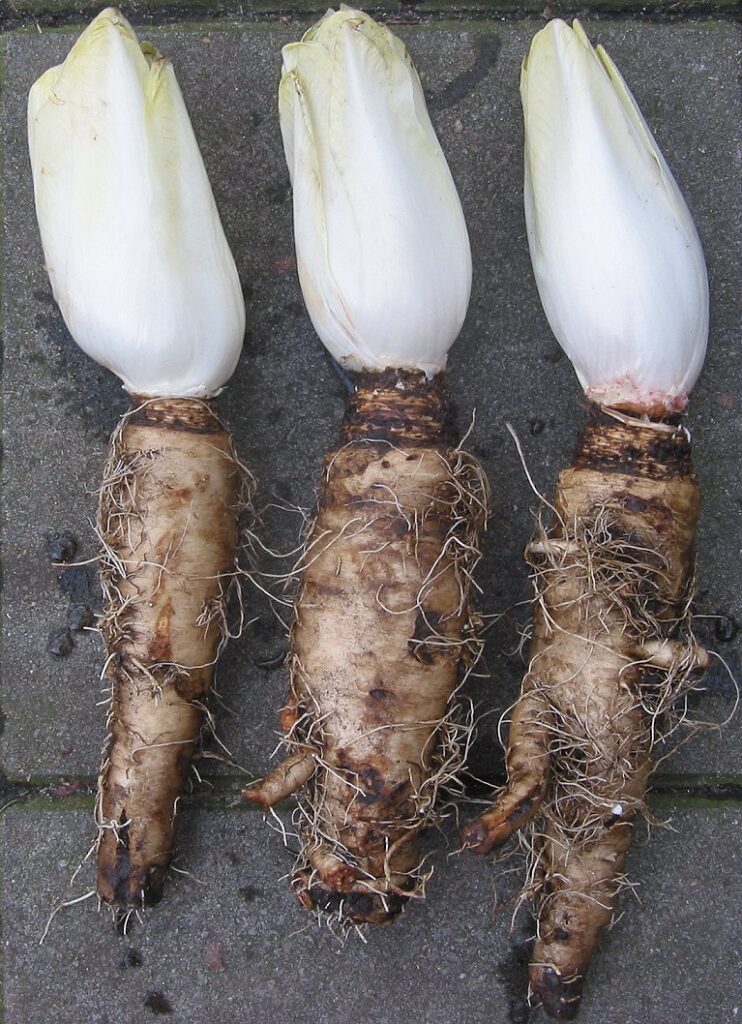
Belgian endive
The Belgian Endive or witloof chicory is a product of the common chicory plant (C. intybus). It is primarily produced in Belgium, France, and the Netherlands. It is a lettuce-like plant with a cylindrical six-inch long head comprised of pale yellow leaves. This chicory plant is produced by harvesting the roots of common chicory and then storing them in a darkened room in just the right conditions, such as temperature and soil conditions. The Belgian endive’s pale yellow or white coloration is a result of its being grown in the absence of any direct sunlight. Given its labor-intensive growing process and import status, the Belgian Endive is rather an exclusive table fare in the United States. See
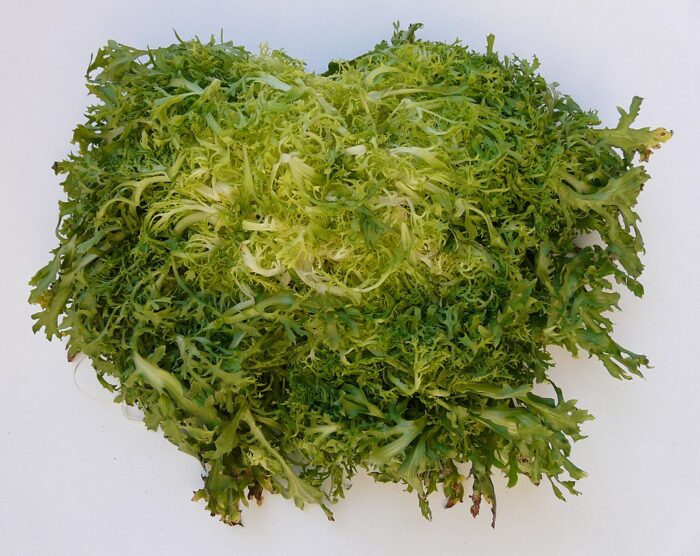
Curly endive
Curly endive, (Cichorium endivia), which is also known as Frisee, has a bushy lettuce-like head, and the bitter-tasting leaves have a lacy texture. Despite the slightly bitter taste, this plant is used as a salad green. It is a separate species but related to common chicory.
Recent Posts
The only venomous snakes in Washington State are Northern Pacific Rattlesnakes. The Northern Pacific Rattlesnake (Crotalus oreganus oreganus) is a sub-species of the Western Rattlesnake. Anyone...
Skunks are not classified as true hibernators. But they go into a state of torpor when the weather gets cold. Skunks are light sleep hibernators, along with opossums, bears, and raccoons. ...

